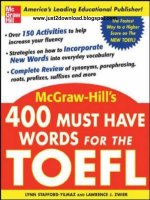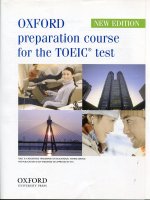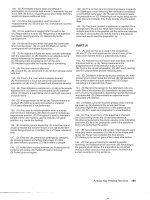Oxford practice test for the toeic PART 1
Bạn đang xem bản rút gọn của tài liệu. Xem và tải ngay bản đầy đủ của tài liệu tại đây (13.04 MB, 114 trang )
ÖXFÔRD PRACTICE TESTS FOR THE TOEICSTESF VOLUME ONE
University Press, Great Clarendon Street, Oxford OX2 6DP
uckland Bangkok Buenos Aires Cape Town Chennai
ares Salaam Dethi Hong Kong /stanbul Karachi Kolkata
uala Lumpur Madrid Melbourne Mexico City Mumbai
airabi Sao Paulo Shanghai Taipei Tokyo Toronto
\XFORD and OXFORD ENGLISH
re trade marks of Oxford University Press
ISBN 0 19 453526 6
Oxford University Press 2000
First published 2000
Fifth impression 2003
No unauthorized photocopying
All rights reserved. No part of this publication may be reproduced,
stored in a retrieval system, or transmitted, in any form or by any
means, without the prior permission in writing of Oxford University
Press, or as expressly permitted by law, or under terms agreed
with the appropriate reprographics rights organization. Enquiries
concerning reproduction outside the scope of the above should
be sent to the ELT Rights Department, Oxford University Press,
at the address above.
You must not circulate this book in any other binding or cover
and you must impose this same condition on any acquirer
Any websites referred to in this publication are in the public domain
and their addresses are provided by Oxford University Press for
information only.
Oxford University Press disclaims any responsibility for the content.
Printed in China
The author and publisher would like to thank Corels for use of
royalty-free images.
Contents
Introduction
page 4
Practice Test 1
page 7
Practice Test 2
page 43
Practice Test 3
page 79
Practice Test 4
page 115
Tapescripts
page 151
page 153
page 158
Test 1
Test 2
Test 3
Test 4
page 163
page 168
Answer key
Test 1
page
page
page
page
page
173
175
187
199
211
page
page
page
page
page
223
225
227
229
231
Test 2
Test 3
Test 4
Answer sheets
Test 1
Test 2
Test 3
Test 4
Conversion table
INTRODUCTION
The Test of English for International
Communication (TOEIC) was originally designed
to test the English proficiency levels of people
engaged in international business. However, the
TOEIC® test has proven to be such a reliable
measure of a test-taker’s English language skills
that it is now used for academic admissions, for
placement purposes, and for measuring
achievement. Over 1,500,000 people take the
TOEIC test each year.
than one meaning (¢.g.,a bottle of port wine
rather than a ship in port). There may be a suitable
word included which is used inappropriately (e.g.,
fe is opening the window. There is a window in
the photo, but nobody is opening it).
Strategies
Scan the picture quickly and try to identify as
much as you can. Ask yourself questions: Who
gender, description, occupation) is in the photo?
What is happening? Where was the photo taken?
When listening, focus on the words that are easier
to hear, the stressed words, as they carry the
TOEIC test format
overall meaning.
The TOEIC test is divided into two sections. These
are Listening Comprehension and Reading. Each
section contains 100 questions. You will need
approximately 2/4 hours to take the test.
Listening Comprehension
Part]
Part
Part Wi
PartIV
Reading
PartV
PartVI
PartVH
Photographs
Question-response
Short conversations
Short talks
Incomplete sentences
Error recognition
Reading comprehension
45 minutes
20
30
30
20
questions
questions
questions
questions
75 minutes
40 questions
20 questions
40 questions
Listening Comprehension
Part I
Photographs
In this part, you will see a photograph and you will
hear four sentences about it. You must choose the
sentence that most closely matches what you see.
‘You will hear the sentences once.
You will identify what you see in the photo. This
may include people, objects, actions and locations
both general and specific. You will also make
assumptions; you may not be able to determine if
something is actually taking place, but from the
clues in the photo, you can assume that it is.
Traps
The three incorrect sentences will contain words
that may make them appear correct. A word may
have a similar sound to something in the photo
(€.g.,a sheep rather than the ship pictured). The
Sentence may contain a word which has more
4
Introduction
Part II
Question-response
In this part, you will hear a question and three
possible responses. You must choose the response
that best answers the question. You will hear the
question and each response once.
The question may ask about people, location, time,
an activity, an event, emotions, reasons, or
opinions. In short, the question could be on
almost any subject.
Traps
As in Part I, words may sound similar or be used
out of context. Words from the question may be
repeated in the response, but be used inaccurately.
In addition, there is a potential trap with grammar.
‘You will hear different types of questions: wbquestions (who, what, when, where, why, and
bow), yes/no questions and tag questions. When
you hear a yes/no or a tag question, you may
assume that the response will begin with Yes or
No,
In the TOEIC test, as in real life, the response
may answer the question indirectly instead. For
example:
fs there any cake left?
(A) I ate the last piece.
(B) Yes, the lake is on the left.
(C) No, I left early.
(A) is the correct option. The respondent doesn’t
answer with yes/no as would be expected.
However, we know the answer is no, because the
respondent ate the last piece.
Strategies
You will have to exercise your short-term memory.
You must remember the question until you have
picked the appropriate response. If you really
don’t know the answer, then guess. Choose the
response that sounds most natural to you, don’t
announcements, weather forecasts, special
bulletins, etc. The questions will ask you to
determine the location, the speaker, the time, the
leave any questions unanswered.
event, of a reason.
Part Wil
Traps
Short conversations
In this part, you will hear a short dialog. You will
read a question and four answer choices in your
test booklet. You must choose the option that best
answers the question. You will only hear the
dialog once.
The question will ask about the general idea of the
conversation; usually it will not focus on specific
details. You will be asked to identify an activity, an
emotion, a relationship, or the location of the
speakers. In some instances you may have to do
some minor calculations based on measurements
in the dialog.
Traps
As in Parts I and 11, words may sound similar or be
used out of context. Words may be repeated in the
options, but be used inaccurately. In addition,
listen out for words that can add to or change
meaning. Listen carefully for words that indicate
time (e.g., before, until, while, afterwards, etc.)
and words that indicate negation (e.g., not, bardly,
seldom, by no means, etc.).
The dialog may compare two or more things so
listen for words that show degrees of
comparisons.
Modals (e.g., can, Could, ought to, etc.) indicate
possibility and advisability. Listen carefully for
modals to determine the intent of the speakers.
Word order is also a potential trap. A sentence.
such as Never bas the weather been so
unpredictable means The weather is usually
predictable.
Strategies
Try to read the question before you hear the
dialog. If you have time, read the answer choices
as well. Look at ail the options, before choosing
your answer. As you listen, imagine the speakers
and their location.
Part IV
Short talks
In this part, you will hear a short monologue about
which you will read two or three questions in your
test booklet. For each question, you must choose
the correct answer from four options. You will
only hear the monologue once.
The talks can be in the form of recorded
The traps that were set for you in Parts L,I and I
are set once again.
Strategies
This is a very difficult section
listen carefully and remember
important that you try to read
you hear the talk. If you have
because you have to
specific details. It is
the questions before
time, try to read the
answer choices as well. However, you should
listen to the whole talk before attempting to
answer any of the questions. Timing is crucial in
this part. If you cannot read and answer the
question in the 8 second pause then don’t worry,
but move on to the next one. Don’t get left behind
on the tape.
Reading
PartV Incomplete sentences
In this part, you will read a sentence with one
word or phrase missing and four possible choices
to fill the blank. You will choose the best word or
phrase.
Both your knowledge of vocabulary and your
knowledge of grammar are tested. You will have to
understand the meaning of the sentence to choose
a vocabulary item. You may have to apply your
knowledge of phrasal verbs and set expressions.
You will, in some instances, have to understand the
grammatical function of the blank to choose the
correct grammatical form of a word. The grammar
forms tested most frequently are verb tense,
pronouns, prepositions, conjunctions and
comparisons with adjectives and adverbs.
Traps
In the items that test grammar, many of the choices
are attractive because they seem to complete the
meaning of the sentence. However, they may not
be grammatically correct. You have to pay close
attention to the word endings and make sure you
choose the correct grammatical form required.
Strategies
You must develop a quick pace for the Reading
section. You have 75 minutes for 100 items. There
are 60 items in PartsV and VI. You should save
most of your time for the reading passages in Part
VIL Try to answer a question in 30 seconds. If the
Introduction
5
answer is not apparent to you, quickly move on.
Return to the unanswered questions after you
reach the end of Part VII. Always go back and
check your answers at the end if there is time.
PartVI
Error recognition
In this part, you will read a sentence with four
words or phrases underlined. You must choose the
underlined word or phrase which is incorrectly
written.
Only grammar is tested. The focus is mainly on
errors with subject/verb agreement, pronoun
agreement, and word family distinctions. Errors
with prepositions are common and occasionally
there will be mistakes with verb tense and verb
form.
The words that are not underlined are always
correct.
Traps
A common trap is to insert a word that does not
belong. This is usually a pronoun in the subject
position e.g., The workers they are on strike,or a
pronoun which is incorrectly used e.g., She is
going to interview Mr Robinson itself.
Strategies
Check each underlined section for an error. If no
error is apparent, take each option and see if that
word or phrase fits the sentence grammatically.
Do not take time to correct an error (even in your
head).
PartVII
Reading
You will read a passage followed by 2~5 questions.
You will have to answer the questions based on
the information in the passage. Each question has
four options.
You will have to interpret the information in
advertisements, forms, reports, correspondence,
tables, graphs, announcements, articles, and
schedules.
Traps
Many of the answer options repeat information
that is found in the passage, but in a different
context. Make sure the option you choose directly
answers the question.
Strategies
Read over the questions before you read the
passage. Don’t look at the answer options. Read
6
Introduction
the passage quickly to get a general idea. Don’t
worry about words you don’t understand. Then
read it again more carefully and try to find the
answers to the questions as you read. After that,
choose from the options. The questions usually
match the order information is presented in the
passage.
Be familiar with the type of passages that will be
presented.
Studying for the TOEIC test
As you take a practice test, pay attention to the
way you work through the test. Keep track of your
time. Note how long you spend on a part; estimate
how long you spend on an item. Ask yourself how
you can improve your speed. Try to develop your
own test-taking rhythm.
Use the cassette tape to develop your memory.
After you take a test, go back to the Listening
section and play the tape again. Try to repeat each
sentence you hear in your head and hold it in your
memory. You can also try this in your own
language when you listen to the radio or
television. Try to repeat exactly what the
announcer says. It is possible to improve your
ability to remember. For the TOEIC test,a good
memory is a necessity.
Use the explanatory answers in the back of this
book. Use them to learn why you made an error
and how the test tried to trap you. There will be a
lot of new words, phrases and ideas in this book.
Taking these practice TOEIC tests will not only
help you become comfortable with the test, but
will definitely help you improve your English.
Answer sheets and Conversion table
In the exam you will have to put your answers on
an Answer sheet, and you can practise doing this
by using the Answer
the book.
sheets provided at the back of
A score conversion table is included on the inside
back cover. This converts the scores of the Oxford
practice tests and does not correlate with the
actual TOEIC tests. The table provides you with an
approximation of your total actual score for the
practice tests,and can be used to assess your
performance as you work through them.
Practice Test One
LISTENING COMPREHENSION
In this section of the test, you will have the chance to show how well you understand spoken English.
There are four parts to this section, with special! directions for each part.
PART |
Directions:
For each question, you will see a picture in your test book and you will hear four.short
statements.
The statements will be spoken just one time. They will not be printed in your test book,
so you must listen carefully to understand what the speaker says.
When you hear the four statements, look at the picture in your test book and choose the statement that
best describes what you see in the picture. Then, on your answer sheet, find the number of the question
and mark your answer. Look at the sample below.
Sample Answer
Now listen to the four statements.
@®@®€@@®
Statement (B), “They're having a meeting,” best describes what you see in the picture. Therefore,
you should choose answer (B).
Practice Test One
8
Practice Test One
Practice Test One
9
10 —
Practice Test One
Practice Test One
11
12
Practice Test One
12.
Practice Test One
13
14.
14 —
Practice Test One
si5274xf
a OSU
15.
Practice Test One
15
16
Practice Test One
Practice Test One
17
PART II
Directions: !n this part of the test, you will hear
responses, also spoken in English. The question
They will not be printed in your test book, so you
say. You are to choose the best response to each
a question spoken in English, followed by three
and the responses wili be spoken just one time.
must listen carefully to understand what the speakers
question.
Now listen to a sample question.
You will hear:
You will also hear:
Sample Answer
@@đoâ
The best response to the question “How are you?” is choice (A), “l am fine, thank you.” Therefore,
you should choose answer (A).
21.
Mark your answer on your answer sheet.
22.
Mark your answer on your answer sheet.
23.
Mark your answer on your answer sheet.
24.
Mark your answer on your answer sheet.
25.
Mark your answer on your answer sheet.
26.
Mark your answer on your answer sheet.
27.
Mark your answer on your answer sheet.
28.
Mark your answer on your answer sheet.
29.
Mark your answer on your answer sheet.
30.
Mark your answer on your answer sheet.
31.
Mark your answer on your answer sheet.
32.
Mark your answer on your answer sheet.
33.
Mark your answer on your answer sheet.
34.
Mark your answer on your answer sheet.
18 —
Practice Test One
35.
Mark your answer on your: answer
36.
Mark your answer on your answer sheet.
37.
Mark your answer on your answer sheet.
38.
Mark your answer on your answer sheet.
39.
Mark your answer on your answer sheet.
40.
Mark your answer on your answer sheet.
41.
Mark your answer on your answer sheet.
42.
Mark your answer on your answer sheet.
43.
Mark your answer on your answer sheet.
44,
Mark your answer on your answer sheet.
45.
Mark your answer on your answer sheet.
46.
Mark your answer on your answer sheet.
47.
Mark your answer on your answer sheet.
48.
Mark your answer on your answer sheet.
49.
Mark your answer on your answer sheet.
50.
Mark your answer on your answer sheet.
sheet.
Practice Test One
19
PART Ili
Directions:
In this part of the test, you will hear thirty short conversations between two people.
The conversations will not be printed in your test book. You will hear the conversations only once,
so you must listen carefully to understand what the speakers say.
In your test book, you will read a question about each conversation. The question will be followed by
four answers. You are to choose the best answer to each question and mark it on your answer sheet.
51.
Where are they?
(A)
(B)
(C)
Ata bus stop.
Ona train.
In a car.
(D)
52.
(C)
(D)
(A)
(B)
(C)
(D)
54,
55.
(B)
(C)
(D)
56.
(C)
(D)
In an engine room.
In an airplane.
Inacar.
in a factory.
He
He
He
He
60.
61.
By
By
By
By
calling the company.
asking the sales rep.
looking at the price list.
checking Anthony’s invoice.
What are they doing now?
(A)
(B)
(C)
(D)
62.
Beside
the water fountain.
On the filing cabinet.
How will the correct price be determined?
(A)
(B)
(C)
(D)
He rarely returns phone calls.
20 ~~ Practice Test One
He was playing sports with friends.
He tripped while walking on the beach.
He-ran into another car.
Where is the key?
(C)
(D)
He is often sick.
an airport.
ahotel.
an office.
arestaurant.
He was in the sun too long.
(A) In the closet door.
He is an asset to the company.
He knows the manager.
In
In
In
In
They are printers.
(B) in the key rack.
can build houses.
is an architect.
teaches.
understands blueprints.
Where are they?
(A)
(B)
(C)
(D)
(B)
59.
They are office clerks.
They are architects.
They are caterers.
How did Sam get hurt?
(A)
A foreign car.
What is known about the new employee?
(A)
58.
Greeting cards.
What is known about Paul?
(A)
(B)
(C)
(D)
(D)
Imported magazines.
Two paperback books.
Where are they?
What do these women do for a living?
(A)
(B)
(C)
”
What does the man want?
(A)
(B)
53.
Ata game.
57.
Swimming.
Hiking.
Bicycling.
Running.
Why is Sue upset?
(A)
Someone broke into her car.
(B)
(C)
She had to pay too much for parking.
She had an accident downtown.
(D)
Someone stole her concert tickets.









